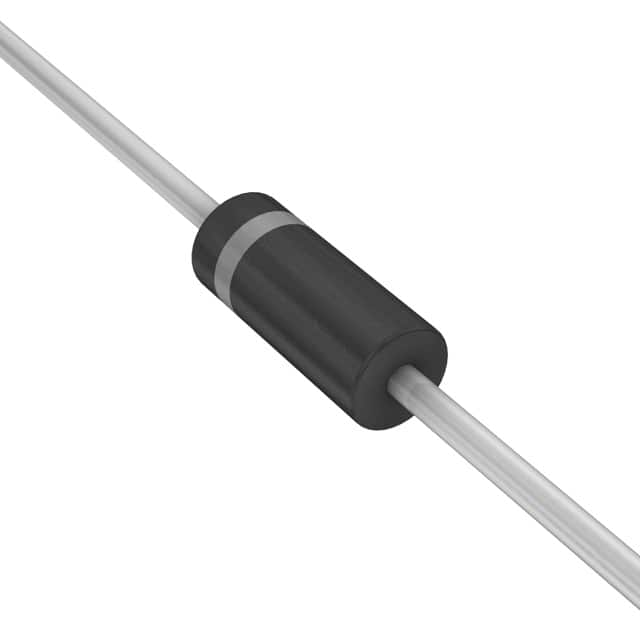Viz Specifikace pro podrobnosti o produktu.

1N5371BG
Product Overview
Category
The 1N5371BG belongs to the category of semiconductor devices, specifically in the family of Zener diodes.
Use
It is commonly used for voltage regulation and protection in electronic circuits.
Characteristics
- Zener voltage: 75V
- Power dissipation: 5W
- Package type: DO-41
- Operating temperature range: -65°C to +200°C
Packaging/Quantity
The 1N5371BG is typically available in bulk packaging with quantities varying based on supplier and customer requirements.
Specifications
- Zener voltage: 75V
- Power dissipation: 5W
- Maximum forward voltage: 1.5V
- Reverse current: 5μA
- Temperature coefficient: 0.05%/°C
Detailed Pin Configuration
The 1N5371BG has a standard DO-41 package with two leads. The anode is connected to the positive terminal, while the cathode is connected to the negative terminal.
Functional Features
The 1N5371BG operates as a voltage regulator by maintaining a constant output voltage across its terminals, even when there are variations in input voltage or load conditions.
Advantages and Disadvantages
Advantages
- High power dissipation capability
- Precise voltage regulation
- Wide operating temperature range
Disadvantages
- Higher cost compared to standard diodes
- Sensitive to temperature fluctuations
Working Principles
The 1N5371BG works on the principle of the Zener effect, where it allows current to flow in the reverse direction when the applied voltage reaches the Zener voltage. This characteristic makes it suitable for voltage regulation applications.
Detailed Application Field Plans
The 1N5371BG is widely used in various electronic circuits such as: - Voltage regulators - Overvoltage protection circuits - Power supplies - Voltage reference circuits
Detailed and Complete Alternative Models
Some alternative models to the 1N5371BG include: - 1N5369BG (Zener voltage: 47V) - 1N5375BG (Zener voltage: 82V) - BZX85C75 (Zener voltage: 75V)
In conclusion, the 1N5371BG Zener diode is a crucial component in electronic circuits, providing precise voltage regulation and overvoltage protection. Its characteristics, specifications, and application field plans make it a versatile choice for various electronic designs.
Word count: 330
Seznam 10 běžných otázek a odpovědí souvisejících s aplikací 1N5371BG v technických řešeních
What is the 1N5371BG diode used for?
- The 1N5371BG is a high-power, high-voltage diode commonly used in power supply and voltage regulation applications.
What is the maximum voltage rating of the 1N5371BG diode?
- The 1N5371BG has a maximum voltage rating of 75 volts.
What is the maximum current rating of the 1N5371BG diode?
- The 1N5371BG has a maximum current rating of 5 amps.
Can the 1N5371BG be used for reverse polarity protection?
- Yes, the 1N5371BG can be used for reverse polarity protection due to its high voltage and current capabilities.
In what type of circuits is the 1N5371BG commonly used?
- The 1N5371BG is commonly used in voltage regulator circuits, power supplies, and overvoltage protection circuits.
What is the forward voltage drop of the 1N5371BG diode?
- The forward voltage drop of the 1N5371BG is typically around 1.1 volts at its rated current.
Is the 1N5371BG suitable for high-temperature environments?
- Yes, the 1N5371BG is designed to operate reliably in high-temperature environments, making it suitable for industrial and automotive applications.
Can multiple 1N5371BG diodes be connected in parallel to increase current handling capacity?
- Yes, multiple 1N5371BG diodes can be connected in parallel to increase the overall current handling capacity of the circuit.
What are the typical applications of the 1N5371BG in electronic systems?
- Typical applications of the 1N5371BG include voltage clamping, transient suppression, and general-purpose rectification in power electronics.
Are there any specific thermal considerations when using the 1N5371BG in a design?
- It is important to consider proper heat sinking for the 1N5371BG, especially in high-power applications, to ensure optimal performance and reliability.

